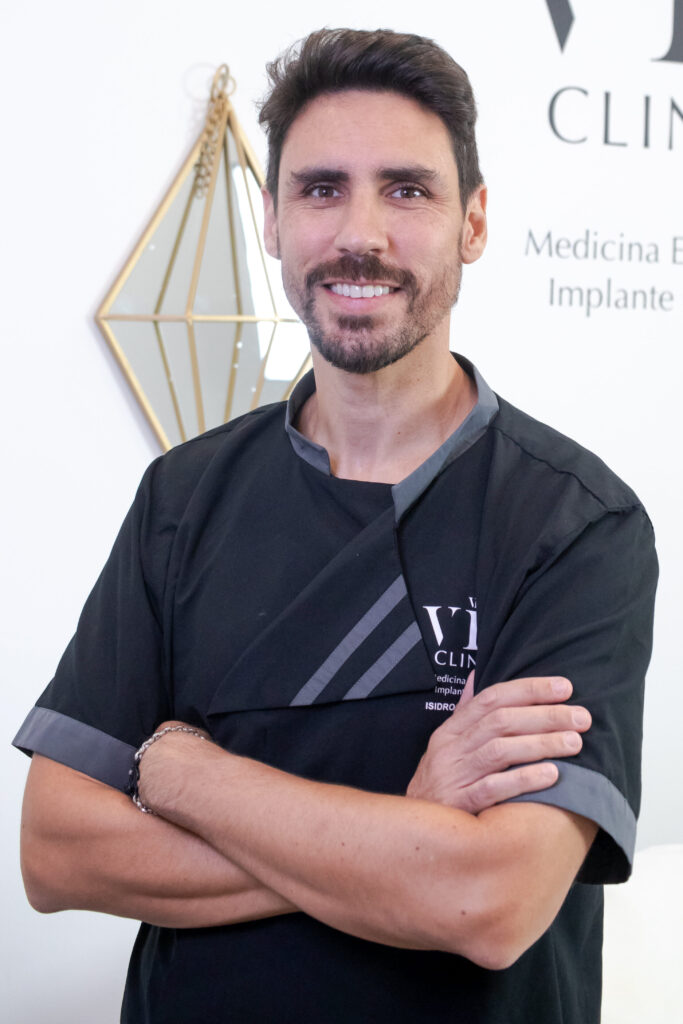Tratamientos Medicina Regenerativa en Alicante
DIFERENTES TIPOS DE PÉRDIDA DE CABELLO
La pérdida de cabello puede manifestarse de diversas formas, y es crucial diferenciarlas, especialmente cuando se consideran opciones de tratamiento de un médico cualificado en tratamientos capilares en Alicante. Comprender el tipo específico de pérdida de cabello que estás experimentando es el paso inicial hacia una restauración efectiva. Estos son los tipos más comunes:
- Alopecia androgenética (calvicie de patrón masculino y femenino): Esta es la forma más prevalente de pérdida de cabello, afectando tanto a hombres como a mujeres. A menudo es hereditaria y resulta en una reducción gradual de la densidad capilar con el tiempo. En los hombres, conduce a la recesión de la línea del cabello y a zonas calvas, mientras que en las mujeres causa adelgazamiento del cabello.
- Efluvio telógeno: El efluvio telógeno, una condición caracterizada por una pérdida de cabello repentina y severa, puede ser desencadenada por varios factores como el estrés, enfermedades, el parto, cirugías o un cambio en la medicación. Típicamente, este tipo de pérdida de cabello es temporal, y el cabello generalmente vuelve a crecer una vez que se resuelve la causa subyacente, lo que lo convierte en un escenario donde el tratamiento médico capilar puede no ser siempre necesario.
- Alopecia areata: La alopecia areata es un trastorno autoinmune que causa pérdida de cabello en parches. En esta condición, el sistema inmunológico ataca por error los folículos pilosos, lo que lleva a la aparición de parches calvos redondos y lisos en el cuero cabelludo u otras áreas del cuerpo.
- Alopecia por tracción: La alopecia por tracción es una condición que resulta de estirar o ejercer una tensión constante y excesiva sobre los folículos pilosos. Las causas comunes incluyen peinados apretados, como trenzas o rastas, y el uso prolongado de extensiones de cabello. Si se detecta temprano, puede ser reversible evitando más estrés en el cabello, y consultar con una clínica capilar en Alicante puede proporcionar orientación sobre un manejo efectivo.

La pérdida de cabello puede ser una experiencia angustiante y desafiante para muchas personas, impactando su autoestima y calidad de vida general. Afortunadamente, los avances en la ciencia médica y la tecnología han dado paso a soluciones efectivas para la pérdida de cabello, y los servicios de trasplante capilar se han convertido en un faro de esperanza para aquellos que buscan restaurar su cabello de forma natural y recuperar la confianza en su imagen. En esta guía completa, exploraremos el mundo de los servicios de trasplante capilar, cubriendo las diferentes técnicas, beneficios, consideraciones y qué esperar del procedimiento.
EL MEJOR TRATAMIENTO PARA LA PÉRDIDA DE CABELLO PARA TI
Encontrar el mejor tratamiento médico para la pérdida de cabello que se ajuste a tus necesidades únicas es un paso crucial en tu camino hacia la restauración capilar. Lo que funciona para una persona puede no ser la elección correcta para otra, y seleccionar la opción de tratamiento más apropiada, ya sea quirúrgica o no quirúrgica, requiere una cuidadosa consideración. Aquí, profundizaremos en los diversos aspectos de elegir el mejor tratamiento médico capilar para tus circunstancias individuales.
Adapta el tratamiento a tus necesidades específicas
Adapta el tratamiento a tus necesidades específicas La pérdida de cabello es una experiencia profundamente personal, y es esencial reconocer que cada caso es diferente. Lo que funciona para alguien con alopecia androgenética puede no ser adecuado para alguien que experimenta pérdida de cabello debido a efluvio telógeno o alopecia areata. Por lo tanto, adaptar tu tratamiento, que puede incluir la mejor medicación para la pérdida y crecimiento del cabello, a tus necesidades específicas es de suma importancia.
Consulta con un médico capilar: El primer y más crítico paso en tu camino para encontrar el mejor tratamiento para la pérdida de cabello es consultar con un médico capilar calificado en una clínica capilar de renombre en Alicante. Realizarán una evaluación exhaustiva de tu pérdida de cabello, teniendo en cuenta tu historial médico, antecedentes familiares y otros factores relevantes. Basándose en esta evaluación, recomendarán un plan de tratamiento adaptado a tus necesidades individuales.
Plan de tratamiento: El plan de tratamiento estará diseñado para abordar la causa de tu pérdida de cabello. Puede incluir una combinación de terapias, como medicamentos tópicos, medicamentos orales, terapia con láser o incluso procedimientos quirúrgicos como trasplantes de cabello. Tu médico explicará la razón detrás de cada tratamiento y cómo funcionan juntos para lograr los mejores resultados.
Consistencia y paciencia: Independientemente del tratamiento elegido, es esencial ser consistente y paciente. La recuperación del cabello lleva tiempo y los resultados pueden no ser visibles inmediatamente. Adherirse al plan de tratamiento prescrito y permitir que los tratamientos surtan efecto es clave.
Protocolo de Cirugía de Trasplante Capilar

Consulta inicial
El proceso comienza con una consulta inicial con un especialista cualificado en trasplante capilar. Durante esta reunión, el especialista evalúa las causas de la pérdida de cabello del paciente, discute los objetivos y expectativas del paciente, y determina la técnica de trasplante más apropiada.

Planificación preoperatoria
Antes del procedimiento, el cirujano delinea la línea del cabello y diseña un plan para la colocación del cabello. Se identifica el área donante, típicamente en la parte posterior o los lados de la cabeza, donde el cabello es más resistente a la calvicie.

Anestesia
El día del procedimiento, se administra anestesia local tanto en las áreas donantes como en las receptoras para asegurar que la cirugía sea indolora. Los pacientes permanecen conscientes durante el procedimiento, pero están cómodos y relajados.
OPCIONES DE TRATAMIENTO MÉDICO CAPILAR
Cuando se trata de abordar la pérdida de cabello, hay varias opciones de tratamiento médico disponibles que pueden ayudar a promover el crecimiento del cabello y disminuir la pérdida adicional. Estos tratamientos suelen ser adecuados para personas que experimentan diferentes tipos y etapas de pérdida de cabello. Aquí, profundizaremos en los detalles de las opciones de tratamiento médico capilar tanto quirúrgicas como no quirúrgicas que se pueden considerar:
Minoxidil (Rogaine): El minoxidil es un tratamiento reconocido para la pérdida de cabello disponible sin receta en forma de espuma o líquido. Se aplica directamente en el cuero cabelludo y está disponible en diferentes concentraciones. El minoxidil es conocido por su capacidad para estimular los folículos pilosos, promoviendo el crecimiento del cabello, lo que lo convierte en una opción adecuada tanto para hombres como para mujeres.
Finasterida (Propecia): La finasterida es un medicamento oral disponible con receta y a menudo se incluye en los planes de tratamiento de pérdida de cabello en línea. Funciona inhibiendo la hormona dihidrotestosterona (DHT), que juega un papel crucial en la pérdida de cabello, particularmente en casos de alopecia androgenética. La finasterida generalmente se receta a hombres y es conocida por ser eficaz para prevenir una mayor pérdida de cabello y promover el crecimiento del cabello en algunos casos.
Terapia con láser de bajo nivel (LLLT)
La LLLT es un tratamiento no invasivo que implica el uso de láseres de baja potencia o diodos emisores de luz (LED) para estimular los folículos pilosos. Esta terapia se puede administrar a través de dispositivos como gorras láser, cascos o peines. Se cree que la LLLT aumenta el flujo sanguíneo al cuero cabelludo y estimula el crecimiento del cabello. Es adecuada tanto para hombres como para mujeres y se puede usar en conjunto con otros tratamientos.
Procedimientos de trasplante capilar
Trasplante de Unidades Foliculares (FUT): El FUT, a menudo referido como el "método de tira", se considera uno de los mejores tratamientos para la pérdida de cabello. Implica la extracción de una tira de piel con folículos pilosos de la parte posterior o los lados del cuero cabelludo. Luego, la tira se disecciona en unidades foliculares individuales y se trasplanta a áreas calvas o con poco cabello. El FUT puede producir un alto número de injertos en una sola sesión, haciéndolo adecuado para casos de pérdida de cabello extensa.
Extracción de Unidades Foliculares (FUE): El FUE es un método más moderno y mínimamente invasivo de trasplante capilar. Los folículos pilosos individuales se extraen uno por uno del área donante, típicamente en la parte posterior del cuero cabelludo, y se trasplantan al área receptora. El FUE deja cicatrices mínimas y permite un resultado de aspecto más natural. Es adecuado tanto para hombres como para mujeres.
Terapia de Plasma Rico en Plaquetas (PRP)
La terapia PRP es un tratamiento regenerativo que utiliza la propia sangre del paciente. Se extrae una pequeña cantidad de sangre, se procesa para concentrar las plaquetas y luego se inyecta de nuevo en el cuero cabelludo. Las plaquetas contienen factores de crecimiento que pueden estimular los folículos pilosos, promoviendo el crecimiento del cabello. El PRP se considera una opción no quirúrgica y a menudo se usa en conjunto con otros tratamientos.
Terapia con células madre
Micropigmentación del cuero cabelludo (SMP)
La SMP es un procedimiento cosmético no invasivo en el que se tatúa pigmento en el cuero cabelludo para crear la ilusión de folículos pilosos. Se utiliza principalmente para camuflar áreas calvas, crear la apariencia de una cabeza recién afeitada o mejorar los resultados de un trasplante de cabello.
Antes del Procedimiento
1. Consulta con tu médico capilar: Tendrás una consulta con tu médico capilar para discutir tus problemas de pérdida de cabello, diagnóstico y plan de tratamiento.
2. Instrucciones pre-procedimiento: Dependiendo del procedimiento, puedes recibir instrucciones específicas, como lavarte el cabello y evitar ciertos medicamentos.
3. Tipo de tratamiento: Dependiendo de tu diagnóstico, puedes someterte a un tratamiento quirúrgico o no quirúrgico.
4. Anestesia (procedimientos quirúrgicos): Para procedimientos quirúrgicos, se administra anestesia local para minimizar las molestias.
5. Preparación del área donante (FUT): En FUT, se prepara el área donante y se recorta el cabello para la extracción.
6. Extracción de folículos pilosos (FUE): En FUE, se extraen folículos pilosos individuales del área donante.
7. Creación del sitio receptor: Se realizan incisiones en el área receptora para la colocación de los injertos.
8. Colocación de injertos: Los folículos pilosos extraídos se colocan cuidadosamente en los sitios receptores.
9. Duración del procedimiento: La duración del procedimiento varía según el tipo y la complejidad del tratamiento.
Después del Procedimiento
1. Cuidados posteriores (no quirúrgicos): Después de aplicar medicamentos tópicos o someterse a LLLT, permite que se sequen y sé consistente con su uso.
2. Cuidados inmediatos post-procedimiento (quirúrgicos): Después de la cirugía, puedes experimentar molestias, hinchazón y sangrado leve.
3. Cuidado del área donante (FUT): Para FUT, mantén el área donante limpia, seca y evita actividades que tensionen el área suturada.
4. Cuidado del área receptora (tanto FUT como FUE): Evita tocar o rascar el área receptora. Sigue las pautas para lavar y limpiar el cabello.
5. Recuperación y cicatrización: Espera que se formen costras y se desprendan los cabellos trasplantados en las semanas siguientes a la cirugía. El nuevo crecimiento del cabello surgirá en los meses siguientes.
6. Citas de seguimiento: Tu médico programará citas de seguimiento para monitorear tu progreso y abordar tus preocupaciones.
7. Cuidado a largo plazo: Continúa con el plan de tratamiento recomendado para el mantenimiento continuo y para preservar los resultados.
Contact us
Preguntas frecuentes sobre tratamientos capilares en Alicante
Al buscar al mejor médico capilar, tenga en cuenta sus cualificaciones, experiencia, opiniones de pacientes y la variedad de tratamientos que ofrece.
Aunque las recomendaciones específicas pueden variar, busque clínicas con buena reputación, personal experimentado y un historial de tratamientos exitosos.
Los tratamientos capilares médicos incluyen opciones no quirúrgicas, como medicamentos tópicos y terapia con láser de baja intensidad, así como procedimientos quirúrgicos, como trasplantes de cabello y terapia con plasma rico en plaquetas (PRP).
El minoxidil y la finasterida son medicamentos de uso común para la caída del cabello. Si bien el minoxidil está disponible sin receta, la finasterida generalmente requiere receta médica. El mejor medicamento depende de su condición específica y debe consultarse con un dermatólogo capilar.
Busque recomendaciones de amigos, familiares y recursos en línea. Consulte a médicos especializados en tratamientos capilares en Alicante, lea reseñas y programe consultas para encontrar un médico que pueda adaptar un plan de tratamiento a sus necesidades.
Sí, el tratamiento de la caída del cabello en línea, incluidas las consultas de telemedicina, es una opción conveniente. Puede consultar con un médico capilar virtualmente, discutir sus inquietudes y recibir recomendaciones de tratamiento.
El mejor tratamiento varía según el tipo y la gravedad de la caída del cabello. Los tratamientos no quirúrgicos como el minoxidil y la terapia con láser son efectivos para algunas personas, mientras que los procedimientos quirúrgicos como los trasplantes de cabello pueden ser apropiados para casos más avanzados.
Al seleccionar un tratamiento, tenga en cuenta factores como la causa y el tipo de pérdida de cabello, su presupuesto, el tiempo de recuperación esperado y los posibles efectos secundarios. Es fundamental consultar a un dermatólogo capilar para tomar una decisión informada.
Sí, existen algunos remedios naturales y cambios en el estilo de vida que pueden promover la salud del cabello, incluida una dieta equilibrada, el manejo del estrés y rutinas adecuadas de cuidado del cabello.
Los resultados de la restauración capilar llevan tiempo. Pueden pasar varios meses antes de que se vean mejoras notables y se necesita paciencia para lograr el resultado deseado.



La terapia con células madre se considera uno de los mejores tratamientos para la pérdida de cabello y es un campo emergente en la restauración capilar. Implica el uso de células madre, a menudo derivadas del propio tejido adiposo del paciente u otras fuentes, para estimular el crecimiento del cabello. Aunque la investigación está en curso, la terapia con células madre muestra potencial como un posible tratamiento no quirúrgico para la pérdida de cabello, convirtiéndola en una opción prometedora para las personas que buscan soluciones efectivas de restauración capilar.